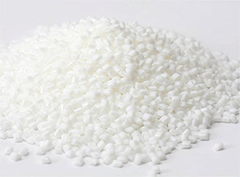
PBT Resin Thin Film type

Specifications
| Trademark | Properties | Application | Viscosity range | |
| XW321 | Ultra-brightness, high transparency and cleanliness, easy for multi-layer coextrusion, excellent film-forming property. | Iridescent film, thin film. | 1.15-1.20 | |
Packing & Storage
| Packaging | The product is packed in a polypropylene woven bag lined with a plastic bag with a net weight of 25kg/bag. | |||
| Storage | The product should be placed in a clean and dry warehouse. The product is a non-dangerous product, non-toxic and odorless. | |||
| Transportation | Sun, rain and mechanical damage should be avoided during transportation. | |||
Free Quote
For samples, pricing, or more information, please call us at 0086 25 51192301 or mail to info@ascent-chem.com or fill out the following form.
We will respond to you as soon as possible.
Tel: 0086 25 51192301
E-mail: info@ascent-chem.com



General Information
Chemical & Physical Information
Safety Information
Synthetic Route
Chemical & Physical Information
| Common Names | PBT Resin Thin Film type | |||
| Structure | C12H12O4)n  | |||
| CAS No. | 26062-94-2 | Melting point (℃) | 226 °C | |
| Molecular Weight | 220.221 | Density | 1.31 g/mL at 25 °C(lit.) | |
| Appearance | pellets | Flash Point | N/A | |
| HS Code | N/A | Autoignition Temperature | >420 °C | |
| Solubility | Insoluble in water | EINECS | 607-857-5 | |
Safety Information
| Safety Statement (Europe) | S24/25 | ||
| RIDADR | NONH for all modes of transport | ||
| Water hazard class (WGK) | 3 | ||
| Hazardous Substances Data | 26062-94-2(Hazardous Substances Data) |
| FIRST AID | |
| Inhalation | If breathed in, move person into fresh air. If not breathing, give artificial respiration. |
| Skin | Wash off with soap and plenty of water. |
| Eyes | Flush eyes with water as a precaution. |
| Inhalation | If swallowed, do not induce vomiting – seek medical advice. |
Synthetic Route
| The production method of PBT basically follows the production technology of PET, but replaces ethylene glycol with 1,4-butanediol.The most suitable processing method for PBT (enhanced and modified PBT) is injection molding. Other methods include extrusion, blow molding, coating and various secondary processing and molding processes. |
Frequently Asked Questions
About Us
Ascent Petrochem Holdings Co., Limited is a company specializes in the processing and marketing industry chain of petrochem and coal chemical industry, by persistently pushing forward with high-tech and service innovation. We are committed to becoming China’s best diversified chemical company which focusing on technologies and services.
Contact Us
